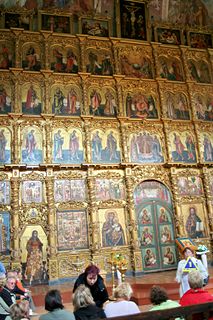 W
WThe Byzantine Rite, also known as the Greek Rite or the Rite of Constantinople, identifies the wide range of cultural, liturgical, and canonical practices that developed in the Eastern Orthodox Church of Constantinople.
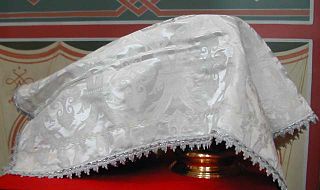 W
WThe Aër is the largest and outermost of the veils covering the Chalice and Diskos (paten) in the Eastern Orthodox Church and the Eastern Catholic Churches which follow the Byzantine Rite. It is rectangular in shape and corresponds to the veil used to cover the chalice and paten in the Latin Rite, but is larger. It is often made of the same material and color as the vestments of the officiating priest, and often has a fringe going all the way around its edge. Tassels may also be sewn at each of the corners.
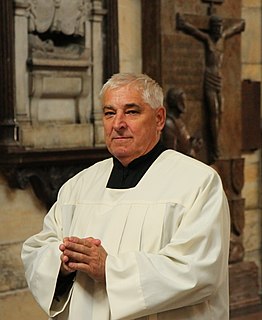 W
WAn altar server is a lay assistant to a member of the clergy during a Christian liturgy. An altar server attends to supporting tasks at the altar such as fetching and carrying, ringing the altar bell, among other things. If young, the server is commonly called an altar boy or altar girl. In some Christian denominations, altar servers are known as acolytes.
 W
WThe Annunciation has been one of the most frequent subjects of Christian art. Depictions of the Annunciation go back to early Christianity, with the Priscilla catacomb in Rome including the oldest known fresco of the Annunciation, dating to the 4th century.
 W
WAn anointing brush is a liturgical brush used in the Byzantine Rite to administer one of the sacred oils: chrism, oil of catechumens, or oil of the sick.
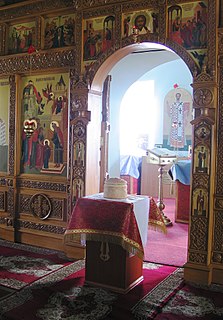 W
WAn artos is a loaf of leavened bread that is blessed during services in the Eastern Orthodox and Byzantine rite catholic churches. A large Artos is baked with a seal depicting the resurrection for use at Pascha (Easter). Smaller loaves are blessed during great vespers in a ritual called Artoklasia and in other occasions like feast days, weddings, memorial services etc.
 W
WBright Week, Pascha Week or Renewal Week is the name used by the Eastern Orthodox and Byzantine Rite Catholic Churches for the period of seven days beginning on Easter and continuing up to the following Sunday, which is known as Thomas Sunday. Latin Rite and other Christian groups such as Anglicans refer to this period as Easter Week, not to be confused with the Octave of Easter, which includes the following Sunday.
 W
WByzantine Rite Christianity in Canada refers to all Eastern Orthodox, Eastern Catholic, and independent groups in Canada who use the Byzantine Rite.
 W
WIn Christian tradition the Churching of Women is the ceremony wherein a blessing is given to mothers after recovery from childbirth. The ceremony includes thanksgiving for the woman's survival of childbirth, and is performed even when the child is stillborn, or has died unbaptized.
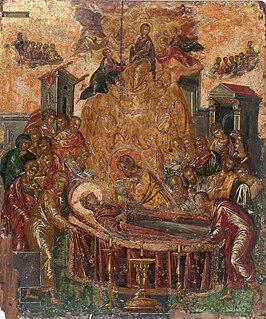 W
WThe Dormition of the Mother of God is a Great Feast of the Eastern Orthodox, Oriental Orthodox and Eastern Catholic Churches which commemorates the "falling asleep" or death of Mary the Theotokos, and her bodily resurrection before being taken up into heaven. It is celebrated on 15 August as the Feast of the Dormition of the Mother of God. The Armenian Apostolic Church celebrates the Dormition not on a fixed date, but on the Sunday nearest 15 August.
 W
WEaster Friday, or Bright Friday, is the Friday after the Christian festival of Easter. At times, this name has been confused with Good Friday, which falls a week earlier.
 W
WEaster Monday is the day after Easter Sunday and is a public holiday in some countries. Easter Monday in the Western Christian liturgical calendar is the second day of Eastertide and analogously in the Byzantine Rite is the second day of Bright Week.
 W
WEaster Saturday, on the Christian calendar, is the Saturday following the festival of Easter, the Saturday of Easter or Bright Week. In the liturgy of Western Christianity it is the last day of Easter Week, sometimes referred to as the Saturday of Easter Week or Saturday in Easter Week. In the liturgy of Eastern Christianity it is the last day of Bright Week, and called Bright Saturday, The Bright and Holy Septave Saturday of Easter Eve, or The Bright and Holy Septave Paschal Artos and Octoechoes Saturday of Iscariot's Byzantine Easter Eve. Easter Saturday is the day preceding the Octave Day of Easter.
 W
WAn ektenia, often called by the better known English word litany, consists of a series of petitions occurring in the Eastern Orthodox and Byzantine Catholic liturgies. The prevalent ecclesiastical word for this kind of litany in Greek is συναπτή synaptê, while ektenia is the word preferred in Church Slavonic.
 W
WThe entrance prayers are the prayers recited by the deacon and priest upon entering the temple before celebrating the Divine Liturgy in the Eastern Orthodox Church and those Eastern Catholic Churches which follow the Byzantine Rite.
 W
WThe Feast of Orthodoxy is celebrated on the first Sunday of Great Lent in the liturgical calendar of the Eastern Orthodox Church and of the Byzantine Rite Eastern Catholic Churches. The Feast is kept in memory of the final defeat of iconoclasm and the restoration of the icons to the churches.
 W
WThe Great Hours, also called the Royal Hours, are a particularly solemn celebration of the Little Hours in the Eastern Orthodox and Eastern Catholic Churches. The Royal Hours is celebrated only three times a year: on the Eve of the Nativity, the Eve of Theophany, and Great Friday.
 W
WGreat Lent, or the Great Fast, is the most important fasting season in the church year in the Eastern Orthodox Church, Byzantine Rite Lutheran Churches and the Eastern Catholic Churches, which prepares Christians for the greatest feast of the church year, Pascha (Easter).
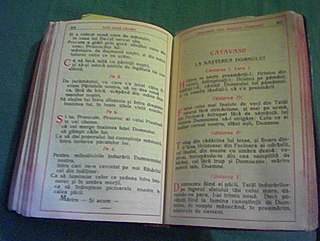 W
WKatabasia or Katavasia is a type of hymn, and the last troparion of an ode of a canon, chanted in the Eastern Orthodox Church and those Eastern Catholic Churches which follow the Byzantine Rite. Its name is derived from the Greek word katabasia for descent, so called because the cantors used to go down from their stalls and unite in the middle of the church to sing them.
 W
WA kathisma, literally, "seat", is a division of the Psalter, used by Eastern Orthodox Christians and Eastern Catholics who follow the Byzantine Rite. The word may also describe a hymn sung at Matins, a seat used in monastic churches, or a type of monastic establishment.
 W
WLazarus Saturday in the Eastern Orthodox Church and Oriental Orthodoxy is the day before Palm Sunday to which it is liturgically linked. It celebrates the raising of Lazarus of Bethany, the narrative of which is found in the Gospel of John.
 W
WThe Liturgy of Preparation, also Prothesis or Proskomedia, is the name given in the Eastern Orthodox Church to the act of preparing the bread and wine for the Eucharist.
 W
WThe Liturgy of Saint John Chrysostom is the most celebrated divine liturgy in the Byzantine Rite. It is named after its core part, the anaphora attributed to Saint John Chrysostom, Archbishop of Constantinople in the 5th century.
 W
WThe Liturgy of the Presanctified Gifts is a Byzantine Rite liturgical service which is performed on the weekdays of Great Lent wherein communion is received from Gifts that are sanctified (consecrated) in advance, hence its name; this Divine Liturgy has no anaphora.
 W
WThe Lity or Litiyá is a festive religious procession, followed by intercessions, which augments great vespers in the Eastern Orthodox and Byzantine Catholic churches on important feast days. Following a lity is another liturgical action, an artoklasia, and either of these terms may be used to describe both liturgical actions collectively.
 W
WByzantine Rite Lutheranism refers to Lutheran Churches, such as those of Ukraine and Slovenia, that use a form of the Byzantine Rite as their liturgy. It is unique in that it is based on the Eastern Christian rite used by the Eastern Orthodox Church, while incorporating theology from the Divine Service contained in the Formula Missae, the base texts for Lutheran liturgics in the West.
 W
WThe Matins Gospel is the solemn chanting of a lection from one of the Four Gospels during Matins in the Orthodox Church and those Eastern Catholic churches which follow the Byzantine Rite.
 W
WA memorial service is a liturgical solemn service for the repose of the departed in the Eastern Orthodox and Byzantine Catholic churches.
 W
WMemory Eternal is an exclamation, an encomium like the polychronion, used at the end of an Eastern Orthodox funeral or memorial service. The same exclamation is used by those Eastern Catholic Churches which follow the Byzantine Rite. It is the liturgical counterpart to the Western Rite prayer "Eternal Rest". The "eternal memory" mentioned in the prayer refers to remembrance by God, rather than by the living, and is another way of praying that the soul has entered heaven and enjoys eternal life.
 W
WMid-Pentecost or Midfeast, also Meso-Pentecost ; Russian: Преполове́ние Пятидеся́тницы is a feast day which occurs during the Paschal season in the Eastern Orthodox Church and those Eastern Catholic Churches which follow the Byzantine Rite.
 W
WA Paraklesis or Supplicatory Canon in the Byzantine Rite, is a service of supplication for the welfare of the living. It is addressed to a specific Saint or to the Most Holy Theotokos whose intercessions are sought through the chanting of the supplicatory canon together with psalms, hymns, and litanies.
 W
WThe Paschal trikirion is a liturgical triple-candlestick used at Easter time in the Eastern Orthodox and Byzantine Catholic traditions.
 W
WThe Paschal troparion or Christos anesti is the characteristic hymn for the celebration of the Orthodox Pascha (Easter) in the Eastern Orthodox Church and churches that follow the Byzantine Rite.
 W
WPraxis, a transliteration of the Greek word πρᾶξις, means "practice, action, doing". More particularly, it means either:practice, as distinguished from theory, of an art, science, etc.; or practical application or exercise of a branch of learning; habitual or established practice; custom.
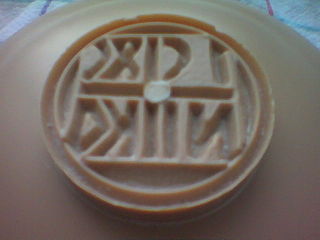 W
WA prosphoron is a small loaf of leavened bread used in Orthodox Christian and Greek Catholic (Byzantine) liturgies. The plural form is prosphora (πρόσφορα). The term originally meant any offering made to a temple, but in Orthodox Christianity it has come to mean specifically the bread offered at the Divine Liturgy (Eucharist).
 W
WSong of Ascents is a title given to fifteen of the Psalms, 120–134, each starting with the superscription Shir Hama'aloth, or, in the case of Psalm 121, Shir Lama'aloth. They are also variously called Gradual Psalms, Songs of Degrees, Songs of Steps, songs for going up to worship or Pilgrim Songs.
 W
WA sticheron is a hymn of a particular genre that has to be sung during the morning (Orthros) and evening service (Hesperinos) of the Orthodox Church and those Eastern Catholic Churches which follow the Byzantine Rite.
 W
W"Beneath Thy Protection" is a Christian hymn. It is the oldest preserved extant hymn to the Blessed Virgin Mary as Theotokos. The hymn is well known in many Roman Catholic, Eastern Orthodox and Oriental Orthodox countries, and is often a favourite song used along with Salve Regina.
 W
WA synaxis is a liturgical assembly in Eastern Christianity, generally for the celebration of Vespers, Matins, Little Hours and the Divine Liturgy.
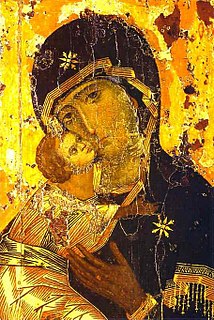 W
WA Theotokion is a hymn to Mary the Theotokos, which is read or chanted during the Divine Services of the Eastern Orthodox and Eastern Catholic churches, as well as in the praises of the Oriental Orthodox churches.
 W
WTypikon is a liturgical book which contains instructions about the order of the Byzantine Rite office and variable hymns of the Divine Liturgy.
 W
WZeon is a liturgical action which takes place in the Divine Liturgy of the Rite of Constantinople, during which hot water is added to the chalice. The same term is used as a noun to describe the vessel used for this purpose.